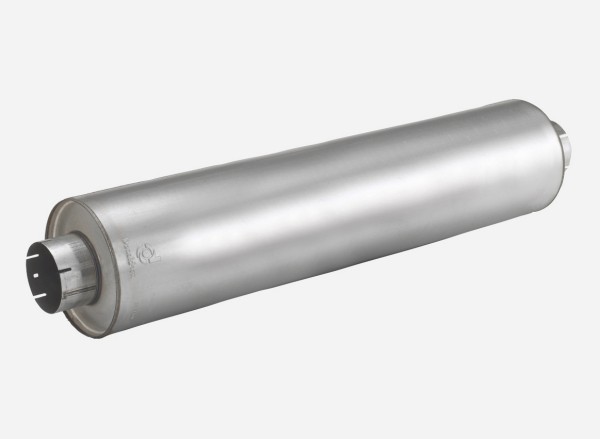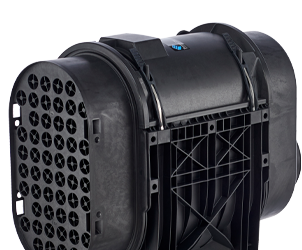Overview
Unique Shapes or Specialty Material, Our Long History in the Sound Attenuating Business Means We Know How to Customize Mufflers

Donaldson has been producing sound-attenuating mufflers for both on- and off-road vehicles since the 1950s. Although many vehicles are transitioning to emission control devices, there is continued demand for sound-attenuating mufflers in some applications. These include vehicles and equipment in countries with less-stringent emissions regulations as well as defense applications. Some vehicles also need sound attenuation beyond what emissions systems provide.

Donaldson offers a portfolio of mufflers for a wide variety of vehicles and equipment that can be customized depending on OEM requirements. Customization options include:
- Sound attenuation
- Backpressure levels
- Muffler shape and inlet/outlet geometry
- Exhaust products material
- Muffler insulation
Features
With an Exhaustive Range, Donaldson Offers Options to Find the Ideal Muffler for Your Application
There are a lot of decisions to be made when choosing a muffler. How should it reduce sound? What level of backpressure is ideal? What material and shape should it be? To assist you in finding the perfect muffler, we’ve described muffler features and the options available with Donaldson mufflers.
Sound Attenuation
Attenuation of exhaust systems refers to the reduction in sound level, measured in decibels (dBAs), between the same engine with and without a muffler. Beyond decibels, the quality of sound, as perceived by people in close proximity, is also important, so mufflers can be designed to provide different sound quality characteristics.
Traditional mufflers use tubes, baffles, expansion chambers and insulation to help control noise. Most current applications include emissions reduction devices that contribute to sound attenuation; however, in certain applications, additional sound attenuation beyond emissions systems is needed.
Engine manufacturers generally expect mufflers to provide a reduction in engine exhaust sound levels of between 15 to 25 dBA. The overall noise level of a vehicle or piece of stationary equipment is the actual regulated value and is typically measured while driving past a microphone at a specific speed and distance. Maximum noise levels are generally regulated by national governmental authorities, although some local limits may also apply.
Heavy-Duty Mufflers Typically Employ One of Three Sound Reduction Techniques Including:



Backpressure Levels

For the most efficient engine performance, a muffler that minimizes backpressure should be your goal. Backpressure is the force necessary to flow gases through the exhaust system, or the resistance to exhaust flow. System considerations include friction and momentum effects (expansion, contraction and elbows) and velocity head loss at the outlet.
Backpressure can reduce horsepower and fuel economy. For example, turbocharged diesel engines lose about 0.5% in horsepower and fuel economy per inch Hg (mercury) backpressure. To minimize backpressure, long tube lengths, small tube diameters and sudden contractions should be avoided.
Muffler Shape and Inlet / Outlet Geometry
The muffler style that can be used is typically dictated by vehicle configuration and the space claim and geometry of the engine compartment. The mounting hardware and its accessibility should also be considered. Common muffler styles are shown below; however, Donaldson can also create custom designs to meet unique OE specifications.
Exhaust Products Material
A number of materials are found in exhaust systems, with different materials often available for use in a single application. The materials vary in their strength, corrosion resistance and price, so a particular material may be preferred in certain applications. Some of the most common materials, their qualities and their typical uses are listed in the table below. If you need help selecting materials, Donaldson engineering experts will be happy to assist.
| Materials | Used In | Qualities |
|---|---|---|
| Aluminized Mild Steel | Mufflers | Good Corrosion Resistance |
| Exhaust Components | ||
| Stainless Steel (with and without aluminized coating) | Flexible Tubing | Stronger, Excellent Corrosion Resistance |
| Mufflers | ||
| Exhaust Components | ||
| Emissions Products | ||
| Chrome | Accessories | Bright Mirror Finish |
| Galvanized | Flexible Tubing | Low material Cost Temperature Limit 315° C / 600° F |
| Cold Rolled | Accessories | Poor Corrosion Resistance Low Cost |
Muffler Insulation

Stock mufflers are produced with no insulation and a single-wall configuration. This is the lowest cost design, but it has the highest system skin temperatures. For applications that require lower skin temperatures, designs can be produced with double walls and an air gap or double walls with insulation. For complete exhaust system thermal coverage, an insulated shell option can be designed to meet unique OE specifications.
Products
Articles
Resources









